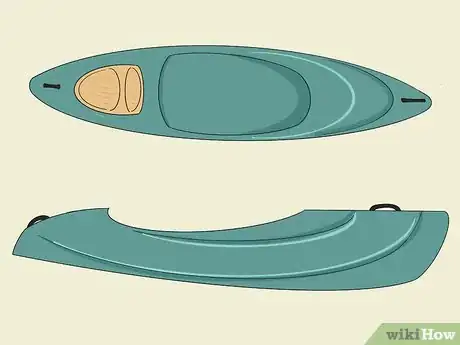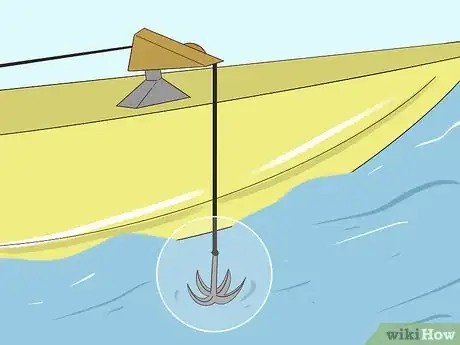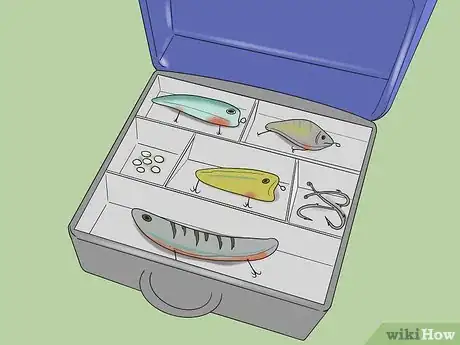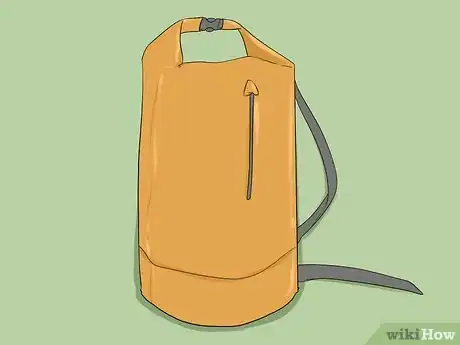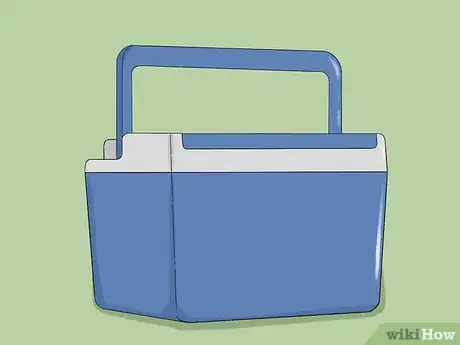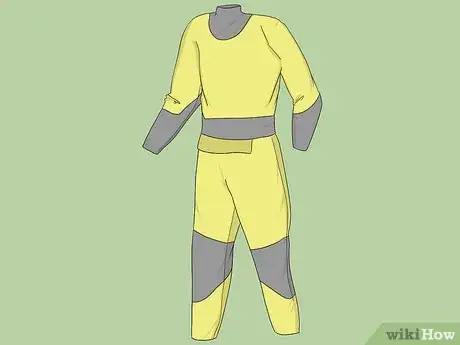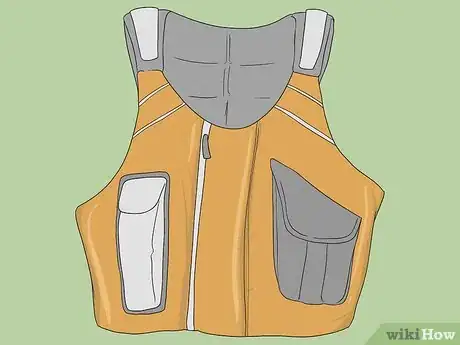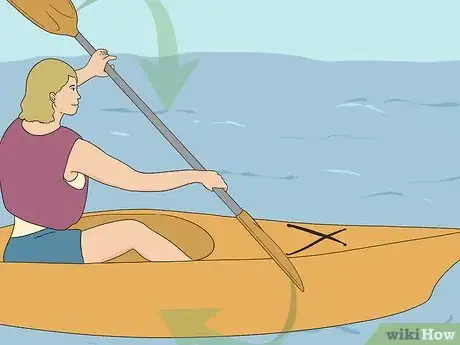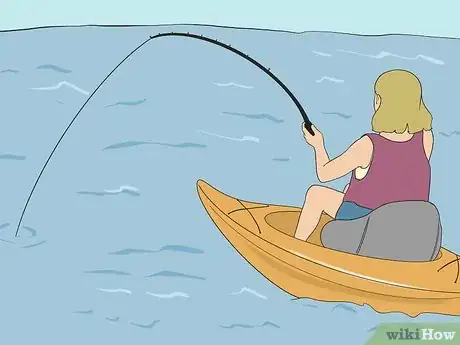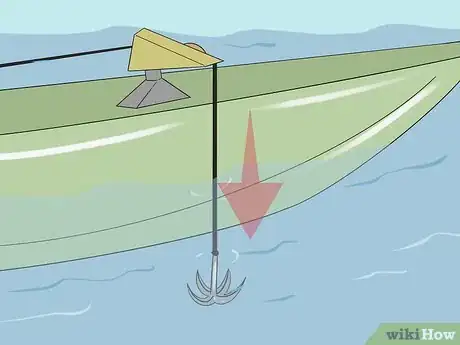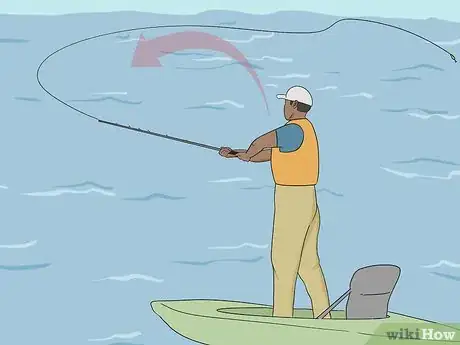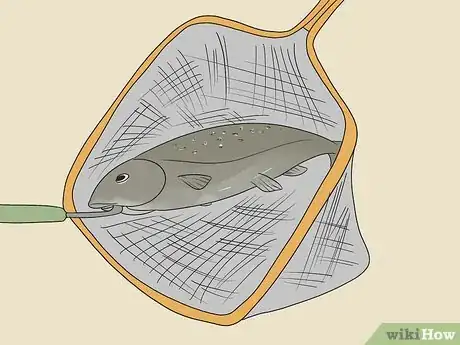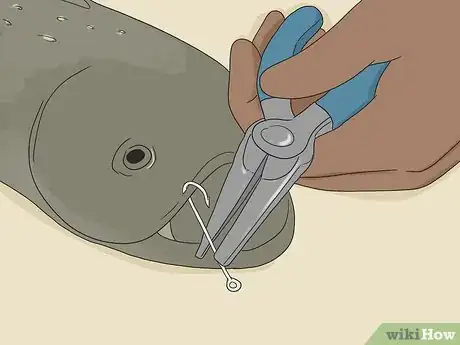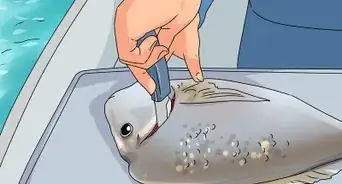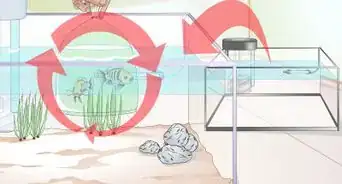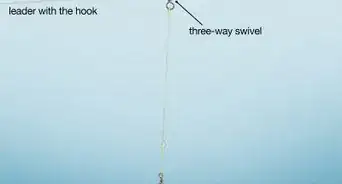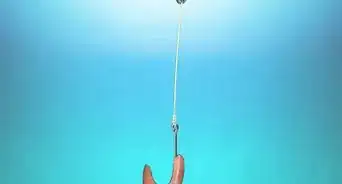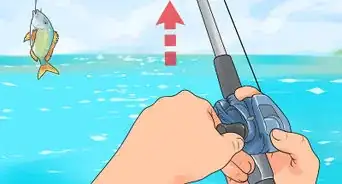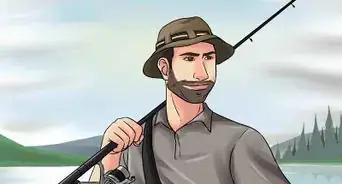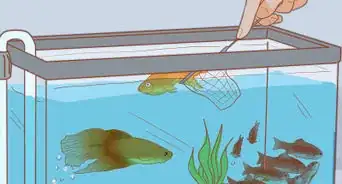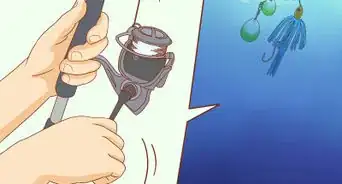This article was co-authored by wikiHow Staff. Our trained team of editors and researchers validate articles for accuracy and comprehensiveness. wikiHow's Content Management Team carefully monitors the work from our editorial staff to ensure that each article is backed by trusted research and meets our high quality standards.
There are 17 references cited in this article, which can be found at the bottom of the page.
This article has been viewed 10,821 times.
Learn more...
Kayaking and fishing are both fun outdoor activities, so combining them is natural. Catching fish from a kayak can be as easy as using a boat as long as you prepare for the unique challenges involved. Kayaks are small and don't have a lot of storage space, so pick equipment that is essential for your trip. Learning how to control a kayak is also important for reaching fish while staying out of danger. When you're ready to cast your line, carefully bring the fish close to the kayak until you're able to sweep it up in a net. Kayak fishing takes control and balance, but it is an activity any water-lover can learn.
Steps
Choosing and Equipping Your Kayak
-
1Select a wide-bottomed kayak for stability while fishing. Getting the right kayak is a big part of fishing successfully. The exact size of kayak you need will depend on your height and weight, but generally, short, wide kayaks are the easiest to control. Look for a kayak with a seat on top as well as additional features like extra storage space and cleats to tie down your gear.[1]
- Speak with a salesperson at an outdoor sporting goods store to find a kayak that suits you. Sturdiness is important, especially for taller people. A wide-bottomed kayak may also allow you to stand up while on the water.
- Spend a little extra to get a kayak with additional features like a good seat, a rod holder, and storage space. One good feature to look for is an oar holster so you can set the paddle down without losing it while you're wrangling fish.
-
2Set up an elevated seat in the middle of the kayak. If your kayak doesn't include a raised seat, purchase one. Fit it against the back of the kayak's seat rest, then look for attachment points on the kayak. The seat will probably have at least one metal clip meant to attach to a cleat near the back of the kayak. After securing the seat, open it so it stays upright.
- A comfortable seat helps a lot with staying comfortable during a long day, but it also makes fishing easier. It elevates you so you can look down at the water and also throw the line further away from the kayak.
- Getting a separate seat is useful if you have a sit-inside kayak. “Sit-on-top” kayaks already have an elevated seat.
Advertisement -
3Choose an inexpensive spinning reel rod for fishing. Don't bring your favorite rod along unless you're prepared to lose it. Pick an affordable rod that is easy to set up and cast while you're sitting inside the kayak. Try using a lightweight carbon fiber rod that is about ½ the length of the kayak. Pair it with a matching reel made of a lightweight material like carbon or magnesium.[2]
- Lightweight rods and reels are better for kayak fishing since they require less energy to cast. When choosing a rod, test it out while you're sitting down. Casting a long distance takes more arm strength when you're sitting.
- Keep in mind that the rod and reel will get wet even if your kayak doesn't flip over.
- Consider getting a detachable rod that breaks apart into several pieces. That way, you can put it together when you need it and take it apart when you're done fishing.
-
4Include an anchor to help keep the kayak from drifting. A small, foldable anchor weighs somewhere between 1.5 to 4 lb (0.68 to 1.81 kg). Most anchors come in carrying bags for easy transportation. You will also need a nylon anchoring rope to knot the anchor to your kayak. A good starting length for the rope is 75 ft (23 m), although you may need to attach the anchor at a different length depending on how deep the water is.[3]
- Lighter anchors work well in most situations, but opt for a heavier anchor if you plan on kayaking into rough waters.
- Many kayaks have a cleat hitch for you to tie the anchor to. If yours doesn't have a hitch, you can buy one and quickly install it using the included metal tabs and screws.
- Some kayaks also have holes in them for anchoring. To use the hole, stick a long stake-out pole through the hole and into the mud. You could also tie the pole to the side of the kayak to stop yourself from drifting.
-
5Bring a small tackle box with bait and other important supplies. Pick a small box that fits inside the kayak. Before you head out on the water, clean out the box. Bring along a couple of tackles and nightcrawlers to use as bait. Limit yourself to a couple of useful tackles and enough bait to get you through your trip.
- Live bait like minnows and worms will also need to be stored on ice for freshness.
- Remember to tie the box to a cleat or another anchor inside the kayak. Keep it underneath or near your seat so you can reach it without much effort.
-
6Store your valuables in a watertight bag. Purchase a marine dry bag to store anything that shouldn't get wet, such as your phone and wallet. Close up the bag and lash it to the inside of the kayak using a nylon rope. Make sure it's secure in case the kayak tips.[4]
- Always bring a charged cell phone in case you need to call for help. Some other gear to consider packing into a dry bag include a camera, money, a GPS, and a compass.
-
7Bring a small ice chest if you're keeping caught fish. Get an old cooler or cooler bag and fill it with plenty of ice. Then, tie it down with nylon rope near the front end of the kayak so it is easily accessible. If you don't have an attachment point for it, you could also get a tie-down kit where you drill into the top of the kayak to screw a mount in place. Use the included nylon straps to secure the cooler to the mount.[5]
- If you don't plan on keeping what you catch, you won't need a cooler unless you're planning on bringing food or drinks you need to keep cool.
-
8Wear loose-fitting clothing that dries quickly. Anticipate the strong possibility of getting wet while you're in the kayak. Stick to quick-drying fishing shirts and pants, since these garments also reduce sun exposure. Look for clothing made of fleece, wool, or polyester. Add additional layers if you plan on going fishing in cooler weather.
- For spring and fall fishing, many kayakers put on a dry suit or flexible waders. You can also get a full-body dry suit for winter. Pair these garments with a warm shirt and waterproof jacket.
- Bring a lightweight waterproof jacket for dealing with splashes or rain. Consider also bringing a warm hat and gloves during cold periods.
- If you fish during the summer, many people stick to bathing suits, shorts, and short-sleeved T-shirts. If you dress this way, be aware of sun exposure by wearing a hat, sunglasses, and sunscreen.
Controlling a Kayak Safely
-
1Put on a life jacket wherever you go out on the water. Kayakers use a personal flotation device (PFD). It is bright and bulky, but it is necessary for staying safe on the water. It's a vest, so slip it on top of your clothes. Make sure it fits you tightly and stands out at a distance.[6]
- You could end up in the water, so you always need to be wearing a PFD. It also helps larger boats spot you and avoid your kayak.
- Consider bringing additional safety gear, including a whistle to alert others, a kayak repair kit, and leashes for your paddle and rod.
-
2Center the heaviest items in the middle of the kayak. These items are most secure when they are at the bottom of the kayak, directly in the center. Your seat will also be close to the center. Put your cooler nearby, followed by your tackle box and anything else you plan on bringing.[7]
- Fit lighter weights at the ends of the kayak, stacking them if needed. Make sure the kayak feels nice and balanced so it is less likely to tip.
- A balanced kayak is also easier to control. If you find maneuvering to be difficult, clear some weight out.
-
3Turn the kayak sideways when you're stepping into it. Getting into a bobbing kayak isn't quite as simple as getting into a boat, but it's not too tough after you stabilize it. Pull the kayak halfway onto solid land, turning it so it's parallel to the shore. Then, step onto it. Make sure all of your gear is in place and tied down before you go out onto the water.[8]
- As long as the kayak is halfway on the shore, it won't be as easy to tip over. If you're trying to climb down from a dock, pull it up beside the dock and lower yourself down slowly.
-
4Paddle with vertical strokes to move the boat at a quick pace. Many kayakers hold the paddle horizontally while dipping it into the water. That style of rowing will tire you out before you ever set up your fishing line. Instead, tilt the rod so the paddle is almost vertical with one end above your head. Dip the other one into the water and push it forward to move the kayak.[9]
- Practice controlling the kayak before attempting to fish in it. You won't be able to fish very well in it until you are used to steering it.
- Alternate sides when paddling. For instance, stroke on the right side, raise the paddle, and then stroke on the left side to move the kayak straight ahead.
-
5Drag the paddle behind the kayak to turn it. Use a technique called a sweep stroke to quickly redirect the kayak. Look to where you want to go, then tilt your body in the opposite direction. Hold the paddle almost horizontally, dipping it into the water. Then, sweep the paddle blade back to turn the kayak.[10]
- Keep in mind that the kayak turns away from where your paddle is. If you stroke the water on the right, the kayak turns to the left. If you use it on the left, it turns to the right.
-
6Cast the rod to help fine-tune your positioning. Since controlling a rod and paddle at the same time is next to impossible, take advantage of your rod. One way to do this is by sweeping the rod through the water like it's a paddle. You can also throw the line out to shift your positioning. The kayak's nose will turn away from where you cast the line.[11]
- Position yourself so you have a clear sight of where you wish to cast the line. Keep in mind that strong winds or currents move the kayak far more than the rod will, so take them into account first.
-
7Climb back into the kayak if you fall out of it. Capsizing is a very real possibility even in calm waters. If you tip over, don't panic. Flip the kayak over and swim up to the side. Raise your chest up until it is near the seat, then pull your legs onto the kayak.[12]
- Practice climbing into the kayak while you're in a calm body of water. Master the technique before you head out.
- Don't go after any gear until you're stable in the kayak. If you tie everything down, you won't need to worry about losing it.
Catching Fish
-
1Choose a type of fish to catch so you know what lures you need. Since you have limited space on a kayak, knowing what you want to catch will help you pack. Figure out what kind of lures and bait are absolutely necessary for your trip. If you're planning on taking a trip to a certain area, research what kind of fish exist there so you don't end up weighing down your kayak with a lot of unnecessary gear.[13]
- If you have time, visit the fishing area. Try fishing there on a boat as well to get more used to the conditions you will face.
- Check out what kind of water traffic to expect in the fishing area and other factors that could affect your trip.
-
2Glide into position using short paddle strokes. One of the biggest advantages of kayak fishing is stealth. Once you notice a school of fish or a good spot where they are likely to gather, start paddling toward them. Use short, gentle strokes to avoid splashing. Try to sweep the paddle close to the boat.[14]
- Loud noises scare away fish, so do your best to be as silent as possible. It will give you an advantage that you wouldn't get from a boat with a loud motor.
- Hitting the kayak is a sure way to scare off fish. To avoid this, move your paddle slowly and with caution. Take your time when positioning the kayak.
-
3Cast the anchor by dropping it into the water while holding the line. Make sure the nylon anchoring rope is firmly knotted to both the anchor and your kayak. Then, maintain your grip on the rope while the anchor slowly sinks. Wait for it to hit the bottom. Then, wait for your kayak to settle before casting your line.[15]
- Use an anchor hitch to secure the anchor.
- Remember to pull open the anchor's prongs before throwing it into the water. When the anchor hits the floor, it turns sideways so the prongs catch on solid ground.
- The kayak will drift in the direction of the water current or wind, so factor in the drift when choosing where to stop.
-
4Sit up straight while moving your arm back to cast the line. Keep the rod positioned horizontally in front of you, then draw it back quickly. Once the hook goes behind your head, snap the rod forward to fling the line ahead of you. You don't have much space, so don't let the hook go back far enough to hit the kayak. Then, hold the rod horizontally again in front of you as you wait for fish to bite.[16]
- Barbed hooks can get stuck on your kayak or worse, someone or something else. A stuck hook is difficult to remove without going back to shore or cutting the line.
- If you are able to stand up in the kayak, you can create more room to maneuver the rod. It's also good for leveraging fish out of the water.
-
5Reel the rod back in when you feel a fish on the hook. Hold the rod up, almost vertically, to pull the fish in with more force. Make sure you leave some slack in the line. If it looks or feels tense, it may snap. Keep reeling, lowering the rod down as needed to reduce the tension.
- Stay still, centered in the boat while you try to bring the fish in. If you lean to the side, you may end up in the water.
-
6Catch the fish with a landing net once it gets close to the kayak. Keep reeling in the fish until it's right up next to your boat. Switch to your net, then sweep it horizontally through the water. If your aim is on point, the fish will be securely in the net. Make sure it's stuck in there before trying to lift it out of the water.[17]
- Bring the fish close enough to the boat so you don't have to lean out to catch it. Leaning too far is a sure way to end up wet, and then you may lose the fish on top of that!
- You could also pull the rod back to flip the fish up in a single, quick motion. It's difficult to do when you're new to fishing and can also lead to a sharp hook flying through the air, so try it with caution.
-
7Pull the hook out of the fish before storing it in ice. Have a small pair of pliers on hand to help unhook the fish without hurting it. Reach into the fish's mouth, then rotate the hook until it points toward you. Slowly pull it out of the fish's mouth. When you're done, store the fish or release it.[18]
- Another option is to buy hooks without barbs. If you have barbed hooks, you could also crimp them by using pliers to crush the barbs. Without the barbs, the hooks become much easier to slide off the fish.
Warnings
- Kayaking is dangerous if you don't take the proper precautions. To prevent drowning, always wear a life jacket while you're out on the water.⧼thumbs_response⧽
- Look out for dangerous weather conditions that can capsize your kayak or make it hard to spot. Don't go out in lightning or deep fog.⧼thumbs_response⧽
Things You'll Need
- Kayak
- Fishing rod
- Spinning reel
- Tacklebox
- Bait
- Tackles
- Ice chest
- Life vest
- Paddle
- Watertight bag for valuables
- Fishing line
- Hook
- Pliers
- Weather-appropriate clothing
- Cleats to tie up gear (optional)
- Nylon rope to tie up gear (optional)
- Oar and rod holders (optional)
References
- ↑ https://www.gearweare.com/how-to-choose-the-best-fishing-kayak/
- ↑ https://www.youtube.com/watch?v=M76q1FrwAmg&feature=youtu.be&t=120
- ↑ https://www.sportsrec.com/201244-how-to-anchor-a-kayak.html
- ↑ https://www.youtube.com/watch?v=4kjv3iKwxdA&feature=youtu.be&t=58
- ↑ https://www.youtube.com/watch?v=PAH4m91UTzM&feature=youtu.be&t=85
- ↑ https://tpwd.texas.gov/fishboat/boat/safety/life_jackets/index.phtml
- ↑ http://www.yakangler.com/kayak-rigging/item/3933-kayak-fishing-camping-trip-tips
- ↑ https://www.youtube.com/watch?v=LOaSwKGExOc&feature=youtu.be&t=56
- ↑ https://www.kayakpaddling.net/2-2
- ↑ https://www.myactivesg.com/Sports/Canoeing/Training-Method/Canoeing-for-Beginners/Recreational-kayaking-How-do-I-turn
- ↑ https://www.youtube.com/watch?v=C7HKe_i4IHM&feature=youtu.be&t=468
- ↑ https://kayakguru.com/kayak-flipping-over-recover/
- ↑ https://www.gearweare.com/how-to-choose-the-best-fishing-kayak/
- ↑ https://www.outdoorveteran.com/ten-tips-mastering-kayak-fishing/
- ↑ http://www.yakangler.com/how-to-paddling/item/86-anchoring-a-kayak
- ↑ https://www.youtube.com/watch?v=-Sv_RM807OI&feature=youtu.be&t=58
- ↑ https://www.youtube.com/watch?v=TK6bEp9P16U&feature=youtu.be&t=25
- ↑ https://www.fishandboat.com/Fish/FishingFundamentals/Documents/play6offhook.pdf
